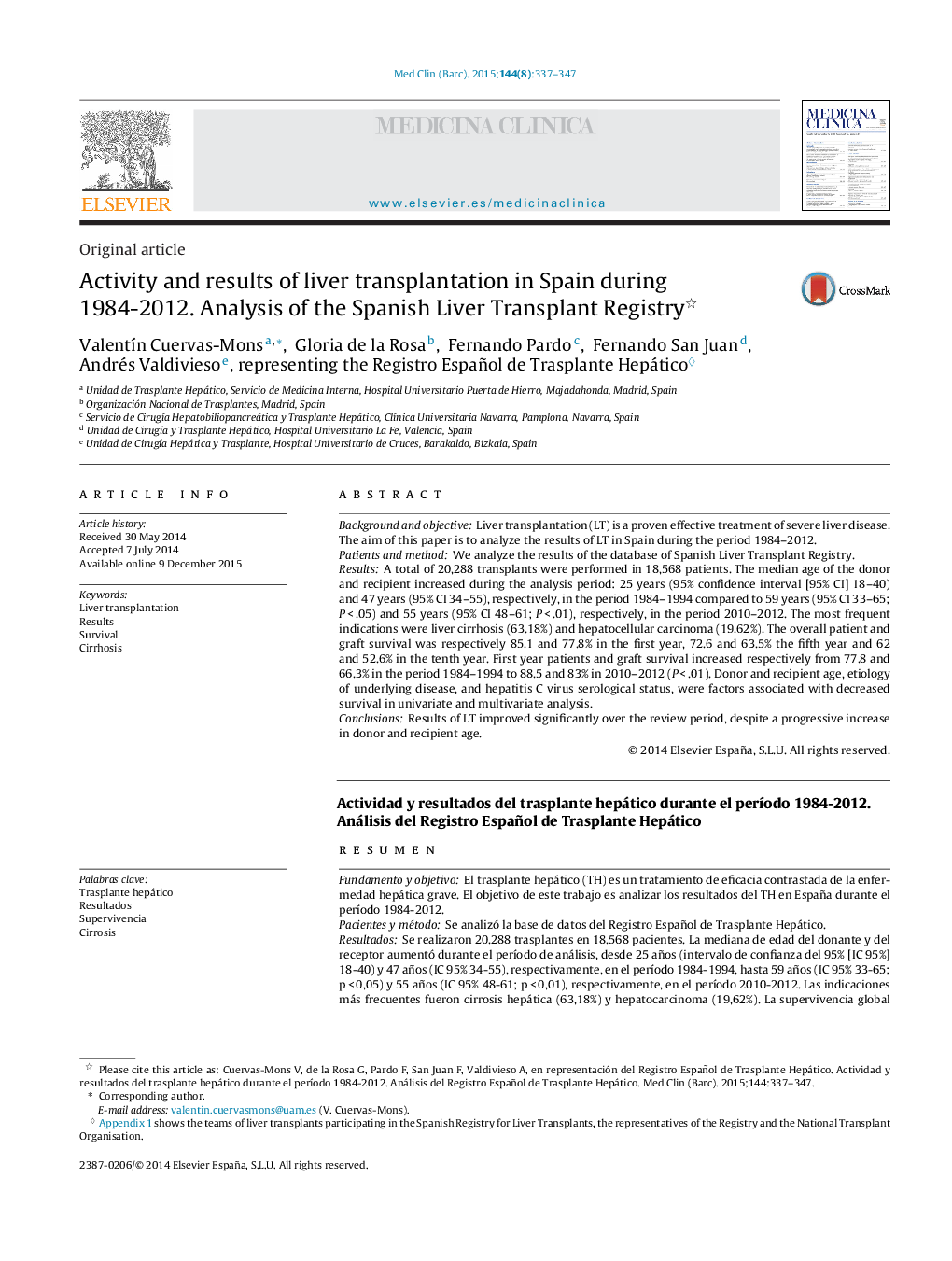| Article ID | Journal | Published Year | Pages | File Type |
|---|---|---|---|---|
| 3805853 | Medicina Clínica (English Edition) | 2015 | 11 Pages |
Background and objectiveLiver transplantation (LT) is a proven effective treatment of severe liver disease. The aim of this paper is to analyze the results of LT in Spain during the period 1984–2012.Patients and methodWe analyze the results of the database of Spanish Liver Transplant Registry.ResultsA total of 20,288 transplants were performed in 18,568 patients. The median age of the donor and recipient increased during the analysis period: 25 years (95% confidence interval [95% CI] 18–40) and 47 years (95% CI 34–55), respectively, in the period 1984–1994 compared to 59 years (95% CI 33–65; P < .05) and 55 years (95% CI 48–61; P < .01), respectively, in the period 2010–2012. The most frequent indications were liver cirrhosis (63.18%) and hepatocellular carcinoma (19.62%). The overall patient and graft survival was respectively 85.1 and 77.8% in the first year, 72.6 and 63.5% the fifth year and 62 and 52.6% in the tenth year. First year patients and graft survival increased respectively from 77.8 and 66.3% in the period 1984–1994 to 88.5 and 83% in 2010–2012 (P < .01). Donor and recipient age, etiology of underlying disease, and hepatitis C virus serological status, were factors associated with decreased survival in univariate and multivariate analysis.ConclusionsResults of LT improved significantly over the review period, despite a progressive increase in donor and recipient age.
ResumenFundamento y objetivoEl trasplante hepático (TH) es un tratamiento de eficacia contrastada de la enfermedad hepática grave. El objetivo de este trabajo es analizar los resultados del TH en España durante el período 1984-2012.Pacientes y métodoSe analizó la base de datos del Registro Español de Trasplante Hepático.ResultadosSe realizaron 20.288 trasplantes en 18.568 pacientes. La mediana de edad del donante y del receptor aumentó durante el período de análisis, desde 25 años (intervalo de confianza del 95% [IC 95%] 18-40) y 47 años (IC 95% 34-55), respectivamente, en el período 1984-1994, hasta 59 años (IC 95% 33-65; p < 0,05) y 55 años (IC 95% 48-61; p < 0,01), respectivamente, en el período 2010-2012. Las indicaciones más frecuentes fueron cirrosis hepática (63,18%) y hepatocarcinoma (19,62%). La supervivencia global del paciente y del injerto fueron, respectivamente, del 85,1 y 77,8% en el primer año, del 72,6 y 63,5% a los 5 años, y del 62 y 52,6% a los 10 años del TH. La supervivencia del paciente y del injerto al primer año aumentó, respectivamente, desde el 77,8 y 66,3% en el período 1984-1994 al 88,5 y 83% en el período 2010-2012 (p < 0,01). La edad del donante y del receptor, la etiología de la enfermedad de base y la serología positiva para el virus de la hepatitis C del receptor se asociaron a menor supervivencia en los análisis univariado y multivariado.ConclusionesLos resultados del TH mejoraron significativamente a lo largo del período analizado, a pesar de un progresivo aumento en la edad del donante y del receptor.
